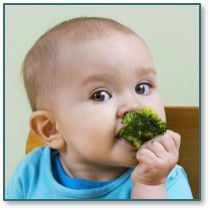Baby-Led Weaning: What It Is, Why It Matters, and How to Start
- The Nourished Queens

- Sep 15
- 3 min read
From One Parent to Another – Nourished Knights
As parents, feeding our babies is one of the first major responsibilities we take on—and it can feel overwhelming. Between advice from doctors, relatives, opinions on social media, and the never-ending aisles of baby food pouches, it’s easy to wonder: Am I doing this right?

One approach that’s gaining momentum (and for good reason) is baby-led weaning (BLW). At Nourished Knights, we believe in raising thriving, strong, and healthy kids from the inside out—and that starts at the very beginning. Baby-led weaning is more than just skipping purées; it’s a powerful way to support your baby’s development from the very first bite.
Baby-led weaning is a method of introducing solids that allows your baby to self-feed soft, appropriately-shaped finger foods, rather than being spoon-fed purées. Around 6 months of age, when babies show signs of readiness, they begin exploring whole foods on their own terms—learning to chew, grasp, and taste without pressure or force-feeding.

This approach does more than build independence—it strengthens vital muscles in the jaw, tongue, cheeks, and lips, which are essential for proper growth of the face, teeth, and airway. When babies are fed mostly purées for extended periods, those muscles don’t get the workout they need. This can lead to underdeveloped jaws, narrow palates, mouth breathing, crowded teeth, and even issues with sleep, behavior, and speech later on. (For more on this refer to our recent blog on, How Food Shapes Your Child’s Face, Breath and Brain).
Why Baby-Led Weaning Matters:
Builds strong jaw and tongue muscles, essential for healthy facial and airway development
Encourages natural chewing and swallowing coordination
Supports fine motor skill development through self-feeding
Promotes a healthy relationship with food and eating independence
Can reduce the risk of picky eating by exposing baby to a variety of tastes and textures
Sets a foundation for better sleep, breathing, and behavior
So, when should you start? Most babies are ready for baby-led weaning around 6 months old, but age isn’t the only factor. You’ll want to watch for a few key signs of readiness before beginning:
Signs Your Baby May Be Ready:
Can sit up with minimal or no support
Has good head and neck control
Shows interest in food (reaches for food, watches you eat)
Can bring objects to their mouth
Has lost the tongue-thrust reflex (doesn’t automatically push food out with their tongue)
Once your baby is ready, you can begin by offering soft, safe foods cut into shapes that baby can grasp—usually finger-length, soft pieces that can easily squish between your fingers. Let your baby explore the food with their hands, mouth, and senses—this is how they learn!
Baby-Led Weaning Basics for a Safe Start:
Begin with one or two meals a day, offering simple whole foods
Food should be soft and easy to mash, yet shaped for grasping
Avoid choking hazards like whole grapes, raw carrots, nuts, or popcorn
Skip sippy cups—opt for open cups or straw cups to encourage proper tongue posture
Eat together as a family to model good chewing and mealtime habits
Understand that gagging is normal and part of the learning process

Want support as you begin? That’s where we come in. At Nourished Knights, we offer a Baby-Led Weaning Course to guide you step-by-step through the process. You’ll learn exactly how to start, what foods to introduce, how to serve them, how to support safe swallowing, and how this all supports long-term jaw and airway health. We give you practical tools, confidence, and peace of mind.
What You’ll Learn in the Nourished Knights Course:
When and how to start baby-led weaning safely
Which foods are best for development and how to prepare them
How to spot developmental readiness signs
How to prevent choking and recognize normal gagging
How BLW supports jaw strength, nasal breathing, and brain development
Easy food ideas and meal plans for beginners
How to foster independence and reduce picky eating long-term
Feeding your baby shouldn’t feel stressful or confusing. With the right approach and support, mealtime can become a joyful, nourishing experience—for both of you.
You’re not just feeding a baby—you’re shaping their airway, brain, and future health.
Let us walk with you as you raise strong, nourished little knights—one bite at a time.



Comments